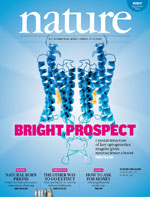
伦敦大学帝国理工学院研究人员发现,一种脂肪传感器GPR120蛋白缺失时,可能会导致肥胖和肝脏疾病。研究结果发表在2月19日出版的Nature杂志上。该研究有望发现治疗肥胖和代谢紊乱新药的有效靶标。
蛋白质GPR120存在于肠道、肝脏和脂肪组织细胞的表层,功能是让细胞对饮食中不饱和脂肪酸,特别是被认为对健康有利的Ω-3脂肪酸进行探测和反应。研究人员发现,当喂食小鼠高脂肪食物时,体内GPR120蛋白质不足的小鼠更有可能患有肥胖和肝脏疾病。他们也发现当编码GPR120基因发生某一特定突变时,这会阻止蛋白质对Ω-3脂肪酸的反应,而这些人肥胖可能性更大。
在肠道里,当食物中的不饱和脂肪酸连接到GPR120,就会刺激荷尔蒙的释放,从而抑制食欲和促进胰腺分泌胰岛素。当GPR120蛋白质探测到血液中脂肪水平较高时,脂肪细胞就会细胞分裂出更多的脂肪细胞储存这些脂肪,减少脂肪肝和动脉积垢的风险。这种机制也是Ω-3脂肪酸带来健康的重要途径。
研究人员用高脂食物来喂养缺少GPR120的小鼠时,小鼠变胖并患有脂肪肝,脂肪细胞的数量低,血糖浓度控制差。研究人员认为,缺乏GPR120蛋白质的小鼠不能在脂肪组织存储多余的脂肪。然而,人体将脂肪储存在引发健康问题的地方,比如肝脏、肌肉和动脉壁上。对人类来说,这种肥胖与2型糖尿病和心脏疾病有关。
Froguel教授说:“如果可以分裂更多的脂肪细胞储存脂肪,体重超重并非不健康。”“但有些人似乎不能这样,只是将脂肪储存在内脏器官附近,这是非常不健康的。我们的研究表明在小鼠和人类身上,GPR120蛋白的缺少和高脂肪饮食会增加这种不健康肥胖的风险。我们认为GPR120可作为治疗肥胖和肝脏疾病新药的有效靶标。”
研究人员分析了6942例肥胖者和7654对照者的GPR120基因,以确定在携带指导蛋白质合成信息的编码上的差异是否与人的肥胖有关。他们发现一种使蛋白质功能异常的突变,增加了60%肥胖的风险。研究人员认为这种突变类似于饮食缺少不饱和Ω-3脂肪酸造成的影响。

Dysfunction of lipid sensor GPR120 leads to obesity in both mouse and human
Atsuhiko Ichimura, Akira Hirasawa, Odile Poulain-Godefroy, Amélie Bonnefond, Takafumi Hara, Loïc Yengo, Ikuo Kimura, Audrey Leloire, Ning Liu, Keiko Iida, Hélène Choquet, Philippe Besnard, Cécile Lecoeur, Sidonie Vivequin, Kumiko Ayukawa, Masato Takeuchi, Kentaro Ozawa, Maithé Tauber, Claudio Maffeis, Anita Morandi, Raffaella Buzzetti, Paul Elliott, Anneli Pouta, Marjo-Riitta Jarvelin, Antje Körner
Free fatty acids provide an important energy source as nutrients, and act as signalling molecules in various cellular processes. Several G-protein-coupled receptors have been identified as free-fatty-acid receptors important in physiology as well as in several diseases. GPR120 (also known as O3FAR1) functions as a receptor for unsaturated long-chain free fatty acids and has a critical role in various physiological homeostasis mechanisms such as adipogenesis, regulation of appetite and food preference. Here we show that GPR120-deficient mice fed a high-fat diet develop obesity, glucose intolerance and fatty liver with decreased adipocyte differentiation and lipogenesis and enhanced hepatic lipogenesis. Insulin resistance in such mice is associated with reduced insulin signalling and enhanced inflammation in adipose tissue. In human, we show that GPR120 expression in adipose tissue is significantly higher in obese individuals than in lean controls. GPR120 exon sequencing in obese subjects reveals a deleterious non-synonymous mutation (p.R270H) that inhibits GPR120 signalling activity. Furthermore, the p.R270H variant increases the risk of obesity in European populations. Overall, this study demonstrates that the lipid sensor GPR120 has a key role in sensing dietary fat and, therefore, in the control of energy balance in both humans and rodents.
文献链接:https://www.nature.com/nature/journal/vaop/ncurrent/full/nature10798.html








